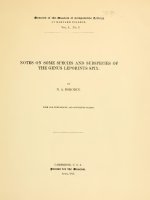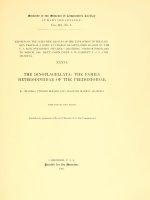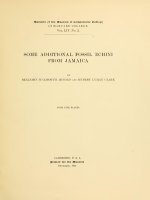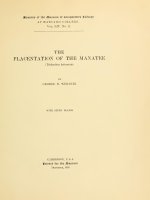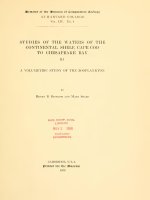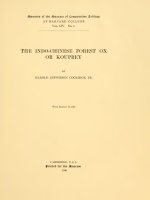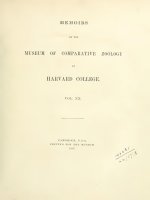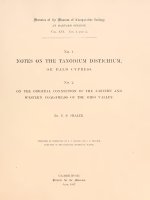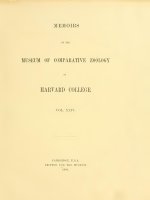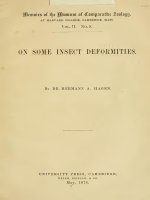Memoirs MCZ 5404
Bạn đang xem bản rút gọn của tài liệu. Xem và tải ngay bản đầy đủ của tài liệu tại đây (12.01 MB, 200 trang )
/Demoirs of tbe /IDuseum of Comparative Zoolocis
AT HARVARD COLLEGE
Vol. LIV.
No. 4
STUDIES OF TPIE WATERS OF THE
CONTINENTAL SHELF, CAPE COD
TO CHESAPEAKE BAY
III
A VOLUMETRIC STUDY OF THE ZOOPLANKTON
BY
Henry
B.
Bigelow and Mary Sears
MUS. COMP. ZOOL
LIBRARY
NOV 2 1964
HARVARD
UNIYERSCDC
CAMBRIDGE,
U.S.A.
IprtnteO for tbe /IDuseum
1939
>>
STUDIES OF THE WATERS OF THE CONTINENTAL SHELF, CAPE COD
TO CHESAPEAKE BAY. III.' A VOLUMETRIC STUDY
OF THE ZOOPLANKTON
By Henry
B.
Bigelow and Mary Sears
Contribution No. 194
From
1
Parts
I
and
the
II
Vol. II, No. 4, 1933
Woods Hole Oceanographic
Institution
appeared in Papers in Physical Oceanography and Meteorology,
and Vol. IV. No. 1, 1935.
CONTENTS
Page
Introduction
189
Acknowledgments
Geographic limits and subdivisions
190
of the area
190
History and sources of information
190
Methods
192
Collection
192
Measurements and calculations
193
Expression of results
196
197
Validitj^ of calculated results
Part
I.
The volume
The water column
of
zooplankton
as a whole
200
200
Seasonal cycle
200
February
200
April
202
May
203
June
206
July
209
Autumn
210
Annual
differences
212
Vertical distribution
214
214
Diurnal stratification
^'ertical stratification other
than diurnal
Comparison with other areas
Relative abundance of different species
Monthly succession
-
221
228
230
February
230
April
231
May
233
June
237
July
241
Autumn
243
Annual
differences
Sources of the local plankton
The
217
area as a feeding ground for plankton-eating fish
245
246
253
memoir: museum of comparative zoology
184
Page
261
Conclusions
The plankton
as a
261
whole
Horizontal distribution
261
Vertical distribution
264
Annual
265
differences
Comparison with other areas
265
Relative importance of different species
265
Feeding conditions for plankton-eating
Part
II.
268
fishes
270
Volumetric distribution of individual species
270
Chordates
270
Doliolum sp
272
Salps
Fritillaria sp
•
273
Oikopleura dioica
273
Oikopleura labradoriensis
274
275
Molluscs
Clione limacina
275
Frequency
275
Abundance
277
Source of the local stock
278
Limacina
reiroversa
279
Frequency
279
Abundance
280
Vertical distribution
284
Relation to temperature
284
Annual variations
284
Source of the local stock
284
Other molluscs
Decapods
Crab and hermit crab larvae
286
286
286
Crago sp
289
Palinurid larvae
290
Lucifer typus
Stomatopods
Euphausiids
Meganyctiphanes norvegica
290
290
291
291
BIGELOW AND SEARS! NORTH ATLANTIC ZOOPLANKTON STUDIES
185
Page
Nematoscelis megalops
293
Thysanoessa inermis
294
Thysanoessa gregaria
295
Thysanoessa longicaudata
296
Euphausiid larvae
297
Other euphausiids
298
Mysids
298
Amphipods
299
Euthemisto compressa
299
Frequency
299
Abundance
300
Annual variations
302
Other amphipods
302
Copepods
303
Acartia
303
Anomalocera pattersoni
304
Calanus finmarchicus
304
Frequency
304
Abundance
305
Breeding periods
310
Vertical distribution
310
Diurnal migration
312
Distribution in relation to temperature
314
Annual fluctuations
316
Calanus hyperboreus
317
Candacia armata
318
Centropages hamatus
320
Centropages typicus
321
,
Frequency
321
Abundance
321
Annual variations
324
Vertical distribution
324
Centropages violaceus
326
Corycaeus sp
326
Eucalanus sp
326
Euchirella rostrata
328
memoir: museum of comparative zoology
186
Page
Mecynoccra clausi
328
Metridia lucens
329
Frequency
329
Abundance
331
Annual variations
333
Oithona sp
333
Oncaea sp
334
Pleuromamma
sp
334
Paracalanus parvus
336
Paraeuchaeta norvegica
337
Pseudocalanus minutus
338
Frequency
338
Abundance
339
Annual variations
340
Bhincalanus nasutus
340
Frequency
340
Abundance
342
ScolecUhrix danae
343
Temora
longicornis
343
Temora
stylifera
Other copepods
345
345
346
Cladocerans
Podon and Evadne
346
Penilia
346
Chaetognaths
Eukrohnia hamaia
Sagitta elegans
347
347
347
Frequency
347
Abundance
349
Annual
differences
351
Sources of the local stock
351
Vertical distribution
352
Sagitta enflata
356
Sagitta serratodentata
356
Frequency
356
Abundance
358
niGELOW ANO sears: north ATLANTIC ZOOPLANKTON STUDIES
187
Page
Annual variations
Other chaetognaths
Annelids
360
360
361
Tomopteris sp
361
Other annelids
361
Medusae
362
digitale
362
Regional distribution
362
Seasonal and annual variations
363
Aglantha
Leptomedusae
Other medusae
365
366
Siphonophores
366
Agalmidae
366
Muggiaea kochii
Other siphonophores
367
367
Ctenophores
368
Beroe sp
368
Pleurobrachia pileus
369
Other ctenophores
370
Protozoans
371
Bibliography
372
INTRODUCTION
111
April, 1!)29, the U. S.
Bureau
commenced an
of Fisheries
investigation of
the distribution of the eggs and larvae of the mackerel in the waters of the continental shelf
between Cape Cod and Latitude about
36°, a
ing the vernal half year, in the three subsequent years.
of
work continued dur-
And
while the collection
plankton was only a secondary goal, samples were systematically obtained on
all cruises,
and turned over to us
for study.
Plankton investigations, we conceive,
and distribution studies
lation
of the relationship of
fall
into
two
of particular species or
one species to another
(e.g.,
chief groups: (a)
popu-
groups of species, or studies
feeding habits of fishes) and (b)
;
attempts to assay the richness of one part of the sea or another, either
production, or as a feeding ground for larger animals.
in organic
Studies of the
first of
these categories depend on enumerations of the specimens present, whether of
different species or of different
have been presented
have been
growth stages
And
of given species.
in the great majority of recent publications
of this sort. If,
the data that
on zooplankton
however, we attempt to approach the matter from the
other angle, information as to the mass of organic matter that
is
present in the sea
from time to time and from place to place becomes of prime import. And very
seldom can this be deduced from a knowledge of the numbers of units of which
this
mass
is
composed, because different planktonic animals, whether different
species or different stages in the
growth
of
one species, vary so widely
counts of total numbers are apt to prove very deceptive,
to total mass.
Part
I of this
if
in size that
interpreted as indices
report attempts to give at least a rough picture of
the latter for the part of the sea in question, together with the proportions in
which the leading species enter into
it.
Part II includes such information as to
the distribution of individual species as our
own
analyses have yielded.
In studies of this sort, the vegetable and animal fractions of the plankton
can be considered either as a unit, or separately: the latter course has seemed to
us preferable, because of the basic difference between the nutritional require-
ments
of the
two
categories.
We must realize, however, whether for the zooplank-
ton or for the phytoplankton, that measurements of mass
may
be
—are only one step
in
our path toward a knowledge of the productivity
of the sea in organic substance.
ment
is
—however precise these
A
second, coincident, and equally vital require-
come only from populaindividuals combined with classification
a knowledge of the rate of overturn, which can
tion studies based
on enumerations
of age-frequencies.
A third essential step is the chemical analysis of the groups of
of
memoir: museum of comparative zoology
190
organisms concerned, for these
differ
one from another,
com-
in the proportional
and sundry other compounds.
a survey of the mass distribution of the
ponents of proteins, carbohydrates, fats,
The
present report, confined to
animal plankton,
is
offered in the
hope that
may
it
larger
serve as a preliminary ap-
proach to the broader field outlined above.
The
on
detailed data (which cannot be reproduced here for lack of space) are
Woods Hole Oceanographic
at the
file
Institution.
ACKNOWLEDGMENTS
Mr. O. E.
Sette, Dr.
Roderick Macdonald, and Dr. George L. Clarke
col-
laborated in identifying the plankton caught during 1929, Miss Alice Beale in
identifying that caught during 1930 and part of 1931.
And
Dr. Th. von Brand
has assisted us by making the ether extracts and the weighings used in our discussions of the area as a feeding ground for plankton-feeding
fish.
GEOGRAPHIC LIMITS AND SUBDIVISIONS
OF THE AREA
The account
from the
tour,
is
ofl[ing of
One
Latitude 36°.
confined to the continental shelf, out to the 200-meter con-
Martha's Vineyard, westward and southward to about
cruise only (February 1931) extended south of
Cape Hat-
Neither was the number of hauls seaward from the 200-meter contour
teras.
large enough, for
any general estimate
For convenience
of plankton
in regional comparisons,
volumes
we have
in the slope water.
arbitrarily divided the
area into a northern sector north from (and including) the Atlantic City profile,
a southern sector, south of the latter, an inshore belt extending 30 miles out from
the coast, and an offshore belt, thence seaward to the 200-meter contour (Fig.
1).
HISTORY AND SOURCES OF INFORMATION
So
far as
we have been
able to learn, the
first
published account of the
zooplanktonic communities of the region in question was Rathbun's (1889) report on tow-net catches
made in April-May
investigations of that year.
1887, in connection with the mackerel
During subsequent years, several notices appeared
of the occurrences of individual planktonic
of the
copepods of the
New Jersey coast
copepods, and amphipods,
etc., of
the
groups for restricted
localities, e.g.,
(Fowler, 1912), of medusae, ctenophores,
Woods Hole
region (Fish, 1925; Hargitt,
1905; Hohnes, 1905; Mayer, 1912; ^Vlieeler, 1901; Wilson, 1932), of copepods
BIGELOW AND SEARS: NORTH ATLANTIC ZOOPLANKTON STUDIES
Fig.
1.
Charts of the area: A, Locations of
present report.
profiles; B, Sub-divisions of the area as
employed
191
in the
192
memoir: museum of comparative zoology
and other groups
for
Chesapeake Bay (Cowles, 1930; Wilson, 1932a). But
it
was
not until 1913 that any systematic survey of the plankton of the continental shelf
was undertaken. In that summer, the U.
lected samples at a grid of stations
S. Fisheries
between the
Schooner "Grampus"
offings of
col-
Cape Cod and
of
Chesapeake Bay, as well as in the Gulf of Maine (Bigelow, 1915). And she surveyed these same waters again in 1916, both in August and in November (Bigelow, 1922).
No
data had, however, been obtained for any other year until 1929,
when "Albatross
were repeated
11" carried out cruises in April,
July.
And
these
months and years:
in the following
— February, April
May,
1931 — February, May, June, July;
June
1932 — February, May
1930
May, June, and
(2 cruises).
June
(2 cruises), July;
(3 cruises).
(4 cruises),
Woods Hole Oceanographic Institution, also made a cruise in
And periodic collecting was carried out from the Institution,
"Atlantis" of the
October 1931.
both with a pump-filter and with tow nets, at a station a few miles off Martha's
Vineyard, from late June 1935 to September 1936 (Clarke and Zinn, 1937).
We
have drawn
by the U.
S.
Bureau
freely
from
all of
the foregoing.
But the
collections
made
of Fisheries during the years 1929-1932, as outlined
above
which forms a sequel to
earlier
have been the chief basis
for the present report,
accounts of the temperature and of the salinity of the same region (Bigelow,
1933; Bigelow and Sears, 1935).
METHODS
Collection
The observing
stations (with few exceptions) were located along the profiles
indicated on Figure
1,
so spaced that on each profile the inshore belt, the mid-
and the outer edge of the shelf were sampled at points seldom more than
15-20 miles apart, and often much closer (for position of stations, etc., see Bige-
belt,
low, 1933, p. 104).
The plan was
the same locaUties, on
six
in
made
belt,
at approximately
the cruises, and this was adhered to as far as practicable,
hundred and four plankton stations on the continental
all,
>
shelf being occupied
377 of them in the northern sector, 227 in the southern, 330 in the inshore
and 274
Most
offshore.
of the hauls
by "Albatross H",
'
all
for observations to be
made by
"Atlantis" in October 1931 were vertical, those
in 1929, horizontal, at the surface,
Bad weather sometimes
interfered,
and some
and (except when
of the cruises were abbreviated.
in very
BIGELOW AND SEARS: NORTH ATLANTIC ZOOPLANKTON STUDIES
shallow water, or
when
at each station.
In subsequent years, on "Albatross 11", oblique hauls were
193
the sea was very rough) at one or more subsurface levels
em-
ployed to obviate the chief shortcoming of horizontal towing, namely, that
may
it
be a matter of chance whether the net hits or misses the strata where the
planktonic population
is
richest or poorest."
Ideally, hauls of this type should be
made by lowering
the net close to the
bottom and by towing in a diagonal direction up to the surface. This, however,
is seldom practical, the best substitute
being to tow in a series of short horizontal
steps at frequent intervals from
The standard procedure
Mo), was to tow
for
bottom to
surface.
in the present case (seldom,
two minutes
at each five
meter
level,
abbreviated to one meter of towing at every ten meter
in order to shorten the time required.
The column
however, attained in
the hauls often being
level, at the
strained in this
deep stations,
way
diverged,
on the average, by about 15° from the horizontal. At a towing speed averaging
1.2 knots or 37 meters per minute (as observed repeatedly), the obUque column
fished through was thus about 370-518 meters long, at stations where the vertical
depth was 20-30 meters, or about 777 meters where the depth was 200 meters.
The
drawback to hauls
chief
of this sort,
from near bottom to surface,
is
that they
give no information as to the degree of stratification of the communities at differ-
ent levels.
at a time,
To meet
this difficulty,
two or more nets were attached on the wire
20-35 meters apart, on the cruises subsequent to February 1931. Un-
fortunately, a considerable proportion of the hauls
next the bottom, equalling as
much
as
50%
of the
left,
unsampled, a stratum
whole vertical distance in ex-
treme cases.
The
nets were either 1-meter, or J^-meter in diameter, of
silk,
the forepart
with 29-38 meshes per linear inch, the rear part with 48-54 meshes per inch.
Nets of these meshes and diameters
may
be expected adequately to sample
planktonic animals of the various groups from the size of the copepod, Centropages,
up
Many
to fish fry.
smaller larval copepods of
And
failure to
sample these
or most of the smaller adult copepods (Oithona),
all species,
is
and other minute animals pass through.
mentioned repeatedly in the following pages.
Measurements and Calculations
Dry weight would
of the plankton,
'
if
be the most reliable index, easily obtainable, to the mass
the desiccation and weighing could be done soon after the col-
For a recent discussion
of the
advantages of oblique towing, see Walford, 1938.
memoir: museum of comparative zoology
194
lections were
made. But,
much more
quired
copepods
number
for so large a
was
assistance than
of samples, this
And
available.
so
much
would have
of the oil
re-
from
— and other substances as well, both from these and from other groups —
dissolves out into the preservative that long preservation of the samples robs
much
dry weighing of
which
is
a
much
We may
of its initial
advantage over volumetric measurement,
simpler procedure.
"volume"
also point out that
is
usually translatable into "wet
(preserved) weight" within a reasonable limit of error, for while the specific
gravities of different groups of planktonic animals differ considerably
life
and
this
—both
in
between shelled pteropods and ctenophores),
after preservation (e.g., as
comparativel}^ constant within each of the major groups.
is
Selected samples, from the collections of 1929, showed the following weight-
volume
relationship,
when weighed
in water:
by displacement; "wet weight," 18.35 gms;
Sagitta elegans, 20 c.c. by displacement; "wet weight," 21.34 gms;
Limacina, 20 c.c. by displacement, "wet weight," 20.18 gms.
Calanus, 20
c.c.
The method
of volumetric
measurement that has most often been used
in
the past consists simply of allowing the catch to settle for a given length of time,
graduated cylinder of convenient
in a
size,
and
of
then measuring
its
bulk.
It
been universally appreciated that the resultant measurements
have only a comparative value, because they include the interspaces between the
has, however,
animals, as well as the latter themselves. Savage (1931, p. 5) has, in fact,
that such measurements
for the
tests,
may
same samples by the
that
we have made
shown
average more than twice as large as those obtained,
so-called displacement method.'
And comparative
for the entire series of "Albatross II" catches for the
year 1929, have similarly shown a wide disparity, with volumes averaging 2-4
times as large
by "settlement"
as
by "displacement,"
for all types of
plankton
combined, the difference being greatest for plankton dominated by sagittae
(extreme case, 105
c.c.
by displacement; 935
ton consisting chiefly of Calanus (210
c.c.
c.c.
by
settlement), least for plank-
by displacement 260
;
c.c.
by settlement).
All measurements in the present report have, therefore, been made by displace-
ment
as follows:
The sample
meshes as
mass
1
is
of
plankton
is first
fine as that of the nets in
then added to a
See Johnstone, 1908,
p.
drained, through a bolting silk strainer with
which the catch was taken. The semi-dried
known volume
of water,
when
the resultant increase in
130 for a general discussion of these methods.
volume
BIGELOW AND SEARS: NORTH ATLANTIC ZOOPLANKTON STUDIES
195
equal to that of the sample, plus the few drops of liquid that
still
is
may
adhere to the latter after draining.
In the preliminary catches of 1929, the respective percentages of the several
constituent species or groups were determined either after these
out, or in
some
cases,
roughly estimated. In the subsequent catches, the volumes
of the species represented
The
total catch
had been sorted
was
most readily separable,
were arrived at as follows:
first
sorted into such of
its
constituent parts as were
e.g., into the chaetognaths, euphausiids, larger medusae,
adult amphipods, pteropods, and "residue," this last consisting chiefly of copepods, with other forms of similarly small size.
Each
of these groupings
was then
measured by the same displacement method as used in obtaining the total volume.
A random and well mixed sample of at least 100 specimens' was then taken from
each grouping, and the number of specimens counted, for each species represented. In order next to calculate the proportional volumes of the several species
included in each grouping, and so to arrive at the total volume of each species in
the total catch,
its
members.
was necessary to weight each according to the average
it
size of
In the cases of Calanus finmarchicus, Centropages typicus, and
Thysanoessa inermis, the weightings were based on actual measurements of the
volume per 100 specimens
range.
of large series of adults, covering the average size
Volumetric comparison with these, by eye, then gave a rough ratio for
weighting the younger stages of these same species, as well as for the other species.
The
following actual example
procedure
may
serve
more graphically
to illustrate the
:
Station,
Montauk
V, June 12, 1930, total volume of catch, 60 c.c, or 480
c.c.
per 20 minutes towing with a 1-meter net; volume of "residue," 59 c.c, or 472
c.c, per standard tow;
number
of individuals of each species represented
119 counted specimens in sample of "residue", 61 Calanus finmarchicus,
tropages typicus, 52 Metridia lucens, 5 Pseudocalanus minutus.
1
Cen-
Weights derived
as above, Calanus, 25; Centropages, 4; Metridia, 25; Pseudocalanus, 2.
lated percentages
among
Calcu-
(volumetric), in "residue", Calanus, 53.7%; Centropages,
0.1%; Metridia, 45.7%; Pseudocalanus, 0.3%. The volume
of "residue" being
472 c.c for the standard haul, the calculated volumes for the several species
work out
1 c.c. of
at 253 c.c. of Calanus;
Fewer,
1
c.c of Centropages; 216
c.c. of
Metridia, and
Pseudocalanus.
Comparison
'
<
if
of catches
there were not that
made
many.
in horizontal hauls at the surface
and deeper
memoir: museum of comparative zoology
196
and
in 1929,
column
through shoaler and deeper sections of the water
in oblique hauls
in 1931
and 1932, afford some information as to the degree
of stratifica-
open nets were used, it is obvious
that the volumes taken in the deeper tows represent not only the abundance prewere
vailing at the towing level, but also whatever was caught while the nets
tion of the plankton in different months. Since
And
being lowered and hauled in again.
this
contamination might well be great
—
enough entirely to obscure the picture in individual case.s
chanced that the net was hauled up through a dense swarm
another.
But
at
most
of the stations, inside the
if,
of
for example,
it
one organism or
200-meter contour, the vertical
sectors averaged less than 1/7 as long as the horizontal sectors in the cases of the
horizontal hauls, and only about 1/15 as long as the horizontal sectors in the
cases of obliques.
It
may,
therefore, be
an important factor for our purposes
numbers
of catches are averaged.
correct for
assumed that
this
contamination
in these shoal waters,
when
is
not
considerable
Consequently, we have not attempted to
it.'
In order to render the catches
standpoint of depth) with those
the catches of the latter
may
the water columns sampled.
made
made
in horizontal
in obliques,
tows comparable (from the
we have
further assumed that
be accepted as representative of the mid-depths of
And
the depths stated in the following discussion
are so derived.
We have credited a value of 1 to catches <
volumes and
1
c.c, in the calculations of average
ratios, while in the case of the latter,
as equivalent to
1
c.c, for the sake of simplicity.
we have
also treated values of
Likewise, in the tables giving
subdivision was
percentages and abundance, a dash signifies that the particular
that the species was not detected in that
not visited on a particular cruise a
;
particular subdivision, though taken in another; a blank that
any subdivision on a particular
in
it
was not detected
cruise.
Expression of Results
The
fact that the catches
were taken
in nets of different sizes, as well as in
hauls of different lengths, some obUque, some vertical, and some horizontal,
makes
it
necessary to reduce
all
the measurements to one
common
basis in order
to render the results comparable, one with another.
The elements on which such
haul are:—
(c)
'
a reduction must be based for
any particular
haul in time,
(a) the diameter of the net used, (b) the duration of the
the average speed of the vessel (or else the linear extent of the haul), and (d)
For a case
of such correction, see
Bigelow and Sears, 1937,
p. 69.
BIGELOVV AND SEARS
NORTH ATLANTIC ZOOPLANKTON STUDIES
:
the efficiency of the purticuhir net used.
hauls, the
first
In
tlie
cases of horizontal
two elements are precisely known, hence the
first
197
and oblique
reduction
is
to
"catch per unit time per unit net-opening"; the standards here adopted being 20
minutes of hauling with a net
is
meter in diameter.
1
But
precise mathematically.
it
Up to this
point, the reduction
does not yet provide a standard of comparison,
unless "time" can be translated directly into "length of water
Close attention was, therefore, paid to the speed of the ship, on
column
all
fished".
the cruises of
"Albatross 11" and of "Atlantis", and records by R.P.M. of the propeller, and
by ship's log, show that this was close to 1.2 knots for the series as a whole. But
whoever has had experience with the differences in the velocities and directions
of currents at different levels in coastwise waters
where the circulation
by the tide, will appreciate that the rate at which a ship
surface water
may
differ
considerably from the rate
is
moving,
some deeper
of
each individual tow, we have, therefore, thought
Rather than attempt the calculation
average speed of 1.2 knots in
all
governed
relative to the
of a net relative to the
at
level.
is
it
water
of the linear extent
preferable to assume an
the calculations, and the catches of the horizontal
and oblique hauls were reduced to the common standard accordingly.
On this basis, the linear extent of the standard tow of 20 minutes would
average 741 meters.
And
there would be as good justification for expressing the
volumes caught "per unit volume
these expressions includes the
impress upon
tlie
translation into
volume
on
of
water" as "per unit time," for the one of
same probable
errors as the other.
reader that neither of these expressions
"volume
of
is
But we must
susceptible of direct
plankton present," whether per unit time or per unit
of water, because of uncertainty as to the efficiency of the nets (discussed
Hence, to avoid any possible misconception as to the rehabihty
p. 198).
observations,
we have endeavored
to
draw a sharp
of the
distinction, in this respect
throughout the descriptive sections of the present report.
It
has also been sug-
gested to us that "catch per unit volume of water" might suggest a higher degree
of precision
able.
We
than "catch per unit tow", whereas actually the two are interchange-
have, therefore, adopted the latter.
All the results, then, are expressed as catch, in c.c. per 20 minutes towing
with a 1-meter net at an assumed speed of
1.2
knots (2222 meters per hour),
unless otherwise stated.
VALIDITY OF CALCULATED RESULTS
No modern student of
we
would claim that quantitative calculations, based on tow nettings, can be any more than approximations to the truth.
plankton,
fancy,
memoir: museum of comparative zoology
198
To
begin with, we must face what
herent in the
be termed the "catching error"
may
as to the rehabiUty of the latter that gave planktonologists so
ing the last quarter of the nineteenth century.
remind the reader that a tow
It
loss
concern dur-
net, of the usual conical form,
and
of
mesh appropri-
somewhat
than the
less
water that would pass through a simple hoop of equal diameter, the
of
the
(i.e.,
much
seems pertinent, however, to
ate for the capture of planktonic organisms, filters
amount
in-
We have no intention of reviving the controversies
tow net method.
amount
regurgitated) depending on the shape of the net, on the
proportionate areas occupied by the threads and by the spaces between the
latter,
and on the pressure,
i.e.,
on the velocity with which the net
through the water. The slower the towing, the more complete
planktonologist knows from observation.
#20) the loss
,
may
drawn
filtration, as
In the case of fine meshed
every
silk (e.g.,
be so serious at ordinary towing speeds as to necessitate special
types of net, to increase the filtering surface relative to the
even with
is
meshed as #0
silk as coarse
the fore parts of our nets, only about
mouth opening. And
(38 meshes per linear inch), such as used in
30%
as
much water would
pass through a
given area, drawn transversely at 2 knots, as through an open cyhnder of the
same
area,
according to the relationship between pressure and filtration in
Hensen's (1895) experiments^
This
loss is so
minimized by the increase
opening, resulting from the conical form, that
at the usual towing speed for our nets,
in straining area relative to
it
probably averaged
less
as
10-30%
or even
recent discussion). Neither
more
is
used, except on rare occasions
(see
Winsor and Walford, 1936,
of the
fails
Much more
plankton that
to capture,
it
serious
is
may
p.
vary as
190, for a
clogging likely to be serious, for nets such as those
when diatoms
or Phaeocystis
the gelatinous bodies of ctenophores, appendicularians,
meshes.
than 10%,
though experiments at various hands have
proved that the catches made in parallel hauls with similar nets
much
mouth
is
may swarm, or when
etc., may block the
the uncertainty as to what relation the fraction
adequately sampled bears to the remainder that the net
being
common knowledge
that no one type of net will equally
well sample the various size categories of planktonic animaLs.
The
nets used in
the present studies (meshes, 38-54 per linear inch) being comparatively coarse,
the failure of small copepods such as Oithona, or the young of others, to figure
more
'
largely in the following volumetric
lists,
does not necessarily
"
.
—
/v«
= \/
Pressure at the given velocity calculated from the formula,
ila, p
•'
V
2k
2g
.
mean
that
BIGELOW AND SEARS NORTH ATLANTIC ZOOPLANKTON STUDIES
199
:
not actually have been present in considerably greater abundance
may
they
(numerically, at least) than the catches would suggest.
In extended surveys, errors also creep in through the fact that
to classify the hauls
by the time
no precise measure
cases,
tance,
i.e.,
by
the duration of the tow
of the speed of the net
remarked
available, as already
is
—
WTiile errors of the sorts just
More
may
vital is the question
generalization for the included area as a whole.
seems to us
of results
necessary
for in
,
through the water,
most
the dis-
i.e.,
reach extreme proportions in
by combining a
sufficiently ex-
whether the grid formed by the
any particular plankton survey, has been
stations, in
—
(p. 196).
mentioned
individual cases, they can usually be minimized
tensive series of data.
it is
close
enough to warrant
In this respect, the consistency
sufficient warrant, as already
argued by Walford (1938) for
a similar survey carried out on George's Bank.
If these
shortcomings of various kinds should chance to be cumulative for a
given haul, the calculated volume for the latter
—perhaps more.
may
much
very likely be as
as
plus or minus error
But, when so many observations are in hand, the
no doubt averages much less than this perhaps not more
than 20-30%, which
is
100%
in error
—
far smaller
that form the basis of study.
than the variations observed among the values
And since the latter also show very clear consistency,
both regional and secular, not only for the volumes of plankton as a whole, but
also for the
ment
may
is
more abundant
of the constituent species,
we think no
further argu-
needed in justification of our conclusion that the picture they have yielded
be accepted as representative (within reasonable limits) of the larger zoo-
plankton from place to place within the area, from season to season, and from
year to year, for the period 1930-1932.
The
basis for comparison
between
this
group of years and the year 1929
not so soUd, because of the use in that year of horizontal hauls. The best
do, in this case,
that were
made
is
to
assume that the average catch,
at different levels at
rect average for the water
that this
marked
is
But from June
temperature tends to become increasingly
tally, at
any particular
thick the stratum
level,
surface.
through the period February-April,
stratification has developed.
how
two or more
is,
we can
of these
each station, at least approximates the cor-
column as a whole, bottom to
close to the truth
doubtful
of the
is
for
It is
i.e.,
probable
before any
on, as the plankton like the
stratified,
which the yield
it
becomes increasingly
of a net
working horizon-
can be accepted as representative.
memoir: museum of comparative zoology
200
PART
I.
THE VOLUME OF THE ZOOPLANKTON AS A UNIT
The Water Column as a Whole
The volumes
in c.c. per
standard haul for each month of the series are shown
on Figures 2-6, 8-9, and average
subdivisions in the following table
Month
:
and
maximum volumes
for
the several
BIGELOW AND SEARS: NORTH ATLANTIC ZOOPLANKTON STUDIES
community
in the waters in question, as in boreal seas in general,
is
at
its
201
lowest
ebb, at the end of winter, or in early spring.
The
Fig.
2.
three surveys for this
month
(1930, 1931, 1932) agree in showing the
of plankton, per standard haul: A, February 5-13, 1930 and February 13-March 5,
1931 (underlined); B, February 10-March 1, 1932, contour lines 100, 500, 1000, 1500, 2000 c.c.
Volumes
and to the south, decreasing
though with great irregularity from station to
volumes as largest over the inner half
offshore
and to the north
station, as
is,
(Fig. 2)
,
of the shelf,
in fact, the case throughout the year.
memoir: museum of comparative zoology
202
The magnitude
perature
may
normal tem-
of this inshore-offshore gradient in winters of
be illustrated by the fact that, of the 37 tows
was 294
1931, the average of the ten closest to shore
made
in 1930
c.c, four yielding
250 c.c, with fourteen hauls over the mid-belt of the
and
more than
shelf averaging 104 c.c,
whereas thirteen along the continental edge averaged only 72 c.c, with four alone
of the latter yielding as
much
The plankton thus averaged roughly
as 100 c.c.
twice as voluminous inshore as along the mid-belt of the shelf, four times as
voluminous as along the outer edge of the
offshore relationship
was
of this
And
most cases the inshore-
in
same order along individual
with occasional exceptions as in 1930 off
c.c.
latter.
at the inshore station, but 191 c.c at the station next seaward,
in 1931, off
though
profiles,
Cape May, where the volume was 136
and again
Martha's Vineyard where the catch closest to land was only 35 c.c,
but 108 c.c farther out.
The
contrast prevaihng at this season between small volumes in the north-
by the New York
eastern sector (bounded
profile)
and
large in the southern
is
February volumes having averaged only about 1/3 as great
for the former as for the latter in 1930 and in 1931 combined, and l/lO as great
even more
striking,
in 1932. Furthermore,
no catch as great as 200
c.c.
was made
in the eastern sector
any February, whereas fourteen such February catches were recorded to the
south and west. But this abundance seems not to extend south of Cape Hatteras
in
"which
may
be regarded as the southern boundary in winter to the cold boreal
water" (Bigelow, 1933,
having yielded only
the advance of spring,
is
tows made in 1931 in the vicinity of the Cape
and 205
c.c.
respectively.
of events in the
development
15, 80, 92,
The sequence
April.
of the plankton, with
obscured in our data by the long period that elapsed be-
and second surveys of each year, no coUectioas having been made
March. In 1930, which we must perforce accept as representative, being the
tween the
in
p. 11),
only year
first
when
collections were
made both
in
volumes had increased about eight or nine fold
February and in April, average
from the one month to the other
over the offshore belt, northward and eastward from the Barnegat
the catch averaged 325
c.c.
of
magnitude
where
in early April, contrasting with 39 c.c. in February.
In the southern sector, however, the volume of plankton
same order
profile,
in April (244 c.c) as
it
had
in
still
averaged about the
February (175
c.c).
This combination of relatively stationary conditions in the south, with
marked augmentation
in the north resulted
—in the year
—
in question
versal of the north-south relationship that existed in February, so that
in a re-
by early
April, the volume of plankton averaged nearly three times as great (419 c.c)
BIGELOW AND SEARS: NORTH ATLANTIC ZOOPLANKTON STUDIES
eastward from the
New York
only about 1/3 as great, as
profile, as
had
it
south of the hitter (157 c.c), instead of
end
at the
203
where
of the winter, this being a case
the north-south gradient would have been hidden, had the comparison been
made between
sectors separated
by the boundary
(Atlantic City profile) that
has usually proved significant.
was not possible to include the immediate offing of Chesacalculation, lacking an oblique haul there in that April. A very
Unfortunately,
peake Bay
in this
it
was made
month, but we
have no information as to whether the average volume had or had not increased
rich surface catch (1200 c.c.)
at this particular locahty
there,
it is
meantime. And volumes
true, in that
for April similarly
averaged
larger in the northern sector than in the southern in 1929, as well.
Vernal augmentation spread southward in 1930, between the
weeks of April as
far as the
ofRng of
And
the
there
Bay
is
where the catches were greater than 500
third
by the expanding
c.c.
(Fig.
3A, B).
evidence of some slight alteration of the same order to the south of
as well,
where the
hauls), contrasting with 98
in the
and
Chesapeake Bay, causing a five-fold increase
since February, along the mid-belt of the shelf, as illustrated
outlines of the area
first
late April average
c.c. (3 stations, 1
was 181
c.c.
(6 stations, oblique
oblique, 2 horizontal hauls), early
month. Consequently, the plankton averaged much the richest along the
mid-belt of the shelf by mid-April of that year (16 stations, average, 496
whereas the coastal waters
c.c.),'
—which had been richest in February—were now
rela-
tively barren (8 stations, average, 192 c.c), as was also the case along the con-
tinental edge (8 stations, average, 133 c.c).
The
facts, (a) that the richest
(Fig. 2, 3)
have not been at the most easterly stations, and
of the Gulf of
Maine
low, 1926; Fish
dominant
aggregations recorded for February and April
is
on the whole sparse in
and Johnson,
species, individually,
1937),
late winter
(b) that the
combined with the vernal
is suflficient
plankton
and early spring (Bigehistories of the
evidence that in years
when volumes
increase significantly in early spring, this results chiefly from local reproduction,
not from immigration from waters farther to the east. Neither have
we any
evi-
dence of mass immigration from oiTshore, or from the south, at this season.
May.
In one of the years (1930)
the area that had been well populated
(
when
> 500
April can be compared with
c.c.)
expanded seaward to the continental edge, by the
of
Chesapeake Bay
to that of
latter, all
along from the
Montauk (though apparently no
oflfing
farther eastward),
In early April, only two stations yielded more than 500 c.c. (Fig. 3A), both of them east of
In late April this was the case at nine stations scattered as far south as Chesapeake Bay.
'
May,
during the earlier month, had
New York.
